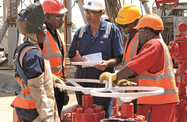Kenya has taken a step towards becoming an energy exporter following the launch of a pilot project aiming to capitalise on the country’s oil resources, with further efforts under way to prepare for full production.

At the start of June Kenya launched the Early Oil Pilot Scheme, with President Uhuru Kenyatta overseeing the first truckloads of crude oil from the South Lokichar Basin in Turkana County to the coastal town of Mombasa about 1000 km away.
The pilot programme will allow UK-based Tullow Oil to begin shipping the roughly 80,000 barrels of oil that has already been extracted and stored at Lokichar for a year. Once transported to Mombasa, the crude will be held in tanks, awaiting eventual export.
The Ministry of Petroleum plans to accumulate 400,000 barrels in Mombasa before it starts shipments, with an international tender for the crude expected to take place before the end of the year.
Together, the Amosing and Ngamia fields in the Lokichar Basin have proven probable resources of 560m barrels of oil, according to Tullow’s 2017 annual report, and plateau production could reach up to 100,000 barrels per day (bpd).
Tullow holds the blocks along with two other partners, Canadian oil and gas company Africa Oil and France’s Total, which acquired shares of Denmark’s Maersk Oil in the blocks in January.
The programme was launched six years after UK and Ireland-listed oil and gas producer Tullow Oil discovered crude in the East African nation’s northern region and is set to last two years. The aim is to test the oilfields’ response to increased output, which will be brought gradually from around 500 bpd to 2000 bpd.
Initially planned for last year, the Early Oil Pilot Scheme was delayed because of a dispute over revenue sharing between the central government and Turkana County communities. An agreement was reached in May, enabling Parliament to vote on a petroleum bill that provided the legislative foundation for the project.
Infrastructure developments prepare for full production
The launch of the pilot strategy comes amid progress in developing the required infrastructure Kenya needs to start full production, which is targeted for 2021/22.
While transporting the oil by truck from the fields to Mombasa is only a temporary measure before commercial operations commence, the long-term solution consists of an 865-km pipeline linking the oilfields to a refinery in the coastal town of Lamu, where a new port is under construction.
The pipeline project had been delayed following disagreements over a planned joint conduit with Uganda, where Tullow is also developing oil reserves.
The two countries have since decided to build two separate pipelines, and in April Tullow picked UK-based Wood Group to design the Kenya pipeline, which is expected to cost $1.1bn.
Meanwhile, at Lamu Port, work is well under way, with about half of the construction of the 32-berth deepwater harbour already completed.
The harbour, estimated to cost $3.1bn, should help Kenya increase cooperation with its landlocked neighbour Ethiopia. In May the two countries signed a deal under which Ethiopia, which mainly relies on Djibouti for its shipments, would acquire land in the port and invest in logistics there.
Oiling the economy greases the wheels of diversification
Joining the ranks of oil exporters would boost Kenya’s revenue and help diversify its economy, which is highly dependent on agricultural exports, notably black tea and cut flowers.
Extraction of natural resources accounted for 1% of GDP last year, compared with 32% for agriculture, forestry and fishing.
Kenya’s crude production is considered profitable with oil prices of at least $55 a barrel, and current prices of around $70 per barrel in mid-June support the business case for developing the sector.
Increased activity in the oil sector is also expected to provide momentum for the development of the larger Lamu Port-Southern Sudan-Ethiopia Transport corridor, known as LAPSSET. The $26m project includes the pipeline and the Lamu Port, as well as new roads and a railway to improve links between Kenya and its northern neighbours, opening up new markets for Kenya’s forthcoming oil supplies.


